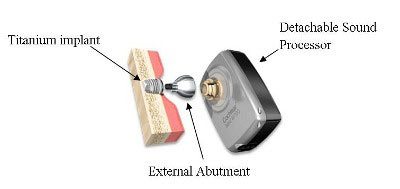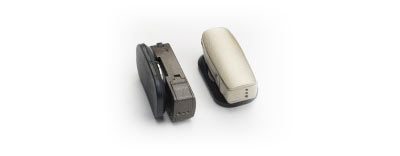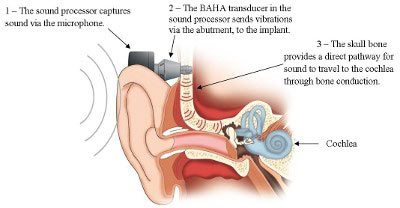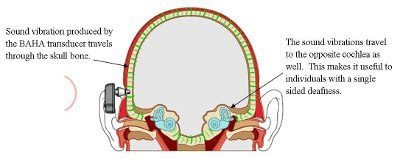Bone Anchored Hearing Systems

What is a Bone Anchored Hearing System (BAHA)?
A Bone Anchored Hearing Aid System (or BAHA) is the only implanted hearing treatment that works through direct bone conduction, working independently of the ear canal and middle ear.
It has been well recognised as a hearing treatment for conductive and mixed hearing loss since 1977, and was approved for Single Sided Deafness (SSD) in 2002.
A BAHA comes in 3 parts:
- The Implant is a tiny titanium screw implanted into the skull, it provides an anchor for the abutment and the sound processor.
- An Abutment is attached to the implant into which the sound processor will then attach.
- The Sound Processor acts as middle ear, converting the sound waves into vibrations, passed through the implant to the bone and from there to the working inner ears.
There are three suppliers of Bone Anchored Hearing System in the UK:
- Cochlear Europe
- Oticon Medical
- Sophono
Conventional Bone Anchored Hearing Systems consist of a titanium implant, an external abutment and a detachable sound processor:

Another type of Bone Anchored Hearing System consists of an internal implanted magnet, an external magnetic spacer and a sound processor.

The image below is of a Oticon Ponto System and shows the Processor, Abutment and Implant:
![]()
Bone Anchored Hearing Systems can also be worn on a softband. This allows for young children to get the benefit of a system, without having the surgery. The softband can also be used to test the sound of a Bone Anchored Hearing System before proceeding with the surgery.
How does a Bone Anchored Hearing System work?


Who Is Suitable for a Bone Anchored Hearing System?
- Conductive Hearing Loss : A conductive hearing loss means that sound cannot travel freely through the ear canal and middle ear to the cochlea. This type of hearing loss can be caused by an abnormality in the structure or blockage (excess ear wax / middle ear fluid) of the outer ear, ear canal or middle ear.
- Mixed Hearing Loss : A mixed hearing loss means that there is both a conductive and senorineural hearing loss (SNHL). A SNHL is hearing loss is a result of damage to the hair cells within the cochlea and/or the hearing nerve. SNHL occurs naturally as part of the aging process, but there are other causes as well.
- Single Sided Deafness (SSD) : A Single Sided Deafness (SSD) means that there is no sufficient hearing function of one cochlea.

